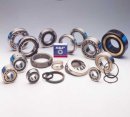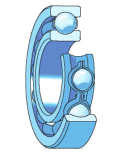
 More about SKF
bearings More about SKF
bearings
 Bearings basics Bearings basics
 Friction Friction
 Protection Protection
 Lubrication Lubrication
 Robustness Robustness
 Precision / ABEC Precision / ABEC
 Mounting / Removing Mounting / Removing
 Cleaning Cleaning

|
 |
Bearings basics
|
|
|
Different
bearing types
There are more than one hundred bearings types with
different shapes and designs. To simplify they can be divided in two main
families, ball bearings and roller bearings. Roller bearings are generally used
in high-load applications. They are often found in industrial applications,
mainly as large size bearings. For skates both inline or quads, or for
skateboards one will never find roller bearings but only ball bearings; more
specifically deep groove ball bearings. To simplify, we will call them ball
bearings in the following pages. Ball bearings are the simplest and most
popular bearings. They are found in large variety of applications, such as
cars, air dryers, washing machines, lifts, etc. Therefore SKF ensures to have
worldwide availability. Further, as most popular ones, they also have an
attractive price.
What is a ball bearing?
A ball bearing
consists of following parts:
An outer ring
An inner ring
A number of
balls
A cage
Lubricant (for sealed bearings)
Protection (sealing)
What is a ball bearing made for?
Ball bearings ensure a
mechanical link between a rotating part and a stationary part. For example:
ball bearings are used to guide and maintain the wheel that is rotating
relative to the axle that is fixed on the frame. The internal design of the
bearing ensures the wheel to have low friction and precise rotation. But we
will come back later on that subject.
When did ball bearings
appear?
Leonardo da Vinci has drawn the first ball bearings in the 15th
century. First prototypes have been made in wood. In the early 18th century,
scientists have thought to make them of steel and to use them in transport
systems. Nevertheless it's only towards the end of the 19th century that ball
bearings have been made to acceptable quality and produced in quantities for
applications such has railways, industrial steam machines, and cars. At that
time, bearing manufacturers made bearings to any dimension, this created a lot
of problems of interchangeability. After world war 1 the bearing manufacturers
begun to think about standards, in order to standardize bearing sizes, and to
define the main characteristics. Though, in the 50's, appeared the ISO
(International Standard Organization) standard systems. These are the only
international standards to describe bearing dimensions and main
characteristics. For example this explains why a ball bearing of dimensions
8x22x7 mm is called 608. Sometimes, like for inline skate bearings, ancient
American ABEC standards are still being used.
Who is manufacturing
ball bearings?
Of course SKF does! Since the beginning the ball bearing
industry was considered as strategic by all industrialized countries. The
bearing industry has become really international over the past 20 years, with
worldwide companies able to provide the complete bearing range. There are 5
important ball bearing manufacturers, said to have high quality and serious
technology. Not all of them produce 608 or mini-bearing sizes like SKF does.
|
|



|
|

